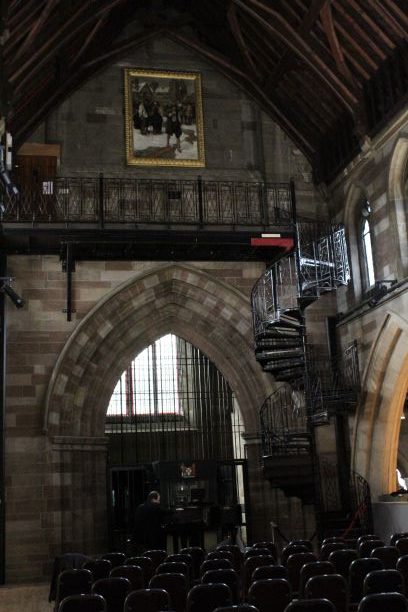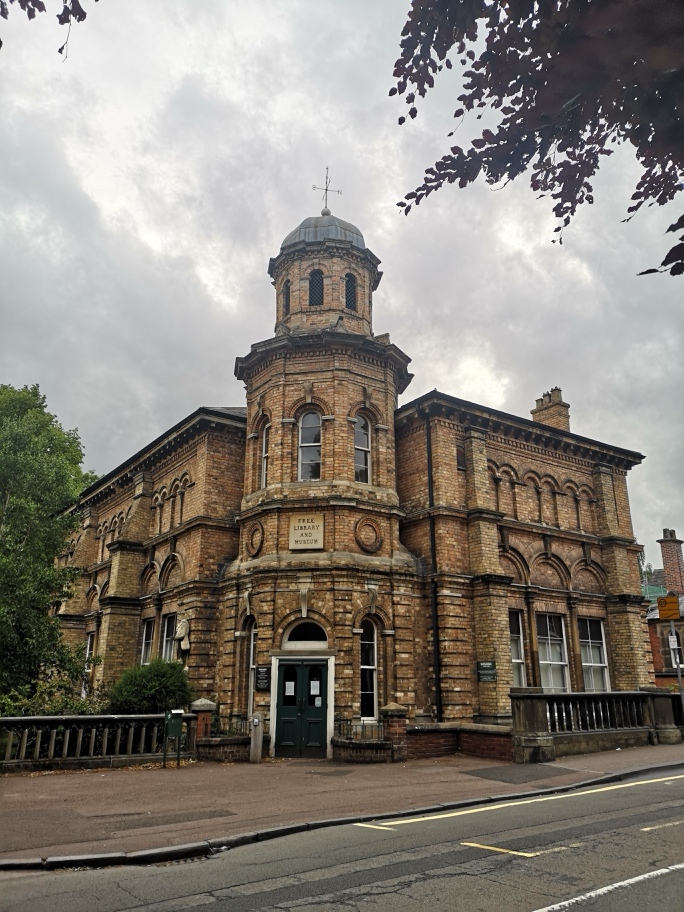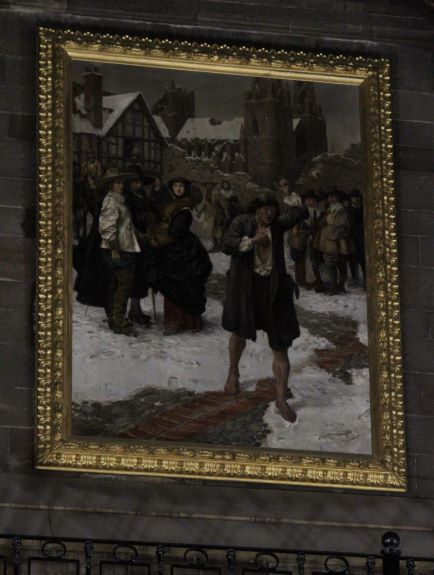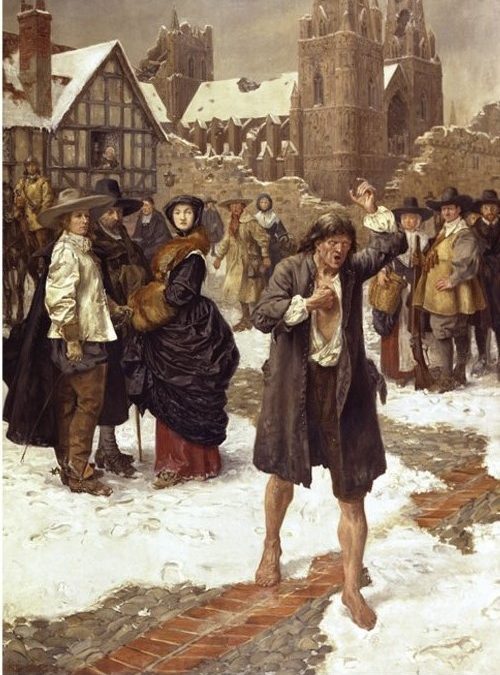George Fox and Bloody Lichfield!
To Great Yarmouth and Back…
Someone asked on Facebook recently where the iconic painting of the religious dissenter, and founder of the Quakers, George Fox striding through the streets of the city shouting ‘Woe to the Bloody City of Lichfield’ was now.

Luckily, as a former museum administrator for Lichfield District Council and a local historian, I knew exactly where the painting was! It hangs on the spire-side wall of St Mary’s Church, now the Hub at St Mary’s, and is on the upper floor, above the viewing platform and the spiral staircase – so you definitely have to look up to see it clearly! But where was it previously…and how did it end up in Great Yarmouth…read on….
George Fox was born in July 1624 in Drayton-in-the-Clay Leicestershire and, from an early age, he started to challenge the widely held religious views of the time. He took to travelling round the country preaching his own views. Fox believed that God could be found anywhere and not just in churches (which he termed ‘steeple-houses’) and he made no clear distinction between the Father, the Son and The Holy Spirit. These dissenting views did not make him universally popular and he was arrested several times after he outlined his views in market places and other public venues.
In 1650 he was arrested and sentenced to jail in Derby for the crime of blasphemy. At his trial Fox had indicated that the word of the Lord caused him to tremble and the Judge humiliated him by calling him, and his supporters, ‘Quakers’.
After he was released from Derby he and his friends headed south and they came upon Lichfield. Fox, apparently, did not recognise the city and asked his friends where it was. On being told Lichfield Fox had a visitation from the Lord, who told him that he should remove his shoes. Although it was mid-winter, and bitterly cold, Fox removed his shoes and handed them to some bemused local shepherds. As he approached the centre of Lichfield the Lord spoke to him again and instructed him to cry out ‘Woe to the Bloody City of Lichfield’. So, Fox strode through the city streets, shoe-less, yelling out this bloody warning much to the amazement, and amusement, of the Lichfield locals. It was fortunate that the locals saw it that way rather than as a Satanical criticism of their city as otherwise Fox may have been hurled in to the City Prison Cells and he may have met the same bloody fate as another dissenter, Edward Wightman, who, in 1612, was burned to death at the stake on market square for the act of heresy! When on the market square Fox had a vision of it, and the streets, being awash with a river of blood. He considered that this may have been because of the bloody executions that had taken place on the square, or because of the legend that a blood battle, and massacre, took place in the 3rd century between a Christian army and a Roman Legion, resulting in the martyrdom of the three slain Christian Kings – and from which Lichfield is named: Field of the Dead…well…allegedly…
Fortunately Fox survived his visit to Lichfield’s market square and he went to form the Religious Society of Friends (known as Quakers after the Derby judge’s put-down remark). He travelled around the country, Europe and the USA, founding the American Friends’ society.
In 1897 the artist Robert Spence produced the painting of George Fox at Lichfield. In the painting Fox is seen striding away from Lichfield Cathedral which is in the background. The central spire is seen as being severely damaged as, in 1646, at the height of the English Civil War, the cathedral had taken a severe pounding and the central spire had collapsed to the ground. When Fox visited in 1651 it was still shattered and it was not restored and replaced until the 1660s, after the Restoration of the monarchy. Bemused onlookers can also be seen watching the raging Fox pound the streets with his dire warning and his shoe-less feet. Spence produced a number of prints of the painting in the early part of the 20th century but the original painting is at St Mary’s. He also produced another etching of the Fox visit, this time Fox is seen outside an inn with yet more puzzled locals staring at him while supping on their pints, although the inn is not identified.
In 1904 Lichfield City Council were informed the local benefactor, Sir Richard Cooper, had purchased the painting on behalf of the council. The painting had been on exhibition at the Royal Academy the previous year and Cooper wanted to bring it to Lichfield. Sir Richard Cooper lived at Shenstone Court and was a major benefactor to Lichfield. Nearly twenty years later he donated the old Friary building to Staffordshire County Council, to become the new Friary School, he personally paid for the construction of The Friary Road in 1928 and, in the same year he personally ,paid for the relocation of the Clock Tower from its previous location at the end of Bore Street to its current location on the Bowling Green roundabout – what a man!

The painting was placed in the museum rooms at the Old Free Library and Museum on Bird Street / Beacon Street. The museum was on the upper floor and the library was on the lower, where the County Council Registry Office is now.
The painting remained there until March 1987 when it was stolen in a brazen robbery. The museum was unattended when the thieves simply walked in and cut the painting out of its frame before causally strolling out, and was taken either late on a Friday afternoon or early on the Saturday morning. The painting measures 10ft by 5ft 6in so is extremely large (and would not fit down your trouser leg!) – so quite how they were allowed to simply walk off with it unnoticed is quite amazing!
The painting remained lost and, just as hope of recovering it was fading, it turned up in an antiques’ shop in Great Yarmouth – clearly the thieves had tried to take it as far away from Lichfield as possible! At the time the painting was valued at £5,000 and the antique dealer clearly realised what it was and notified the police accordingly.

When it was returned to Lichfield it was restored and placed back in its frame before returning to its new location at the Lichfield Heritage Museum (now the Hub at St Mary’s). It is one of the few items of the (large) Lichfield District Council-administered museum collection that is still on public display as the main bulk of the collection is currently in long-term storage.
Once the Hub at St Mary’s is open again why not go and take a look at George Fox as he stands high on the spire wall of St Mary’s Church, berating the Bloody City of Lichfield!
Jono Oates
5 June 2020
*Image of the painting is from the Lichfield District Council website, all other images are copyright Jono’s Tourism.




